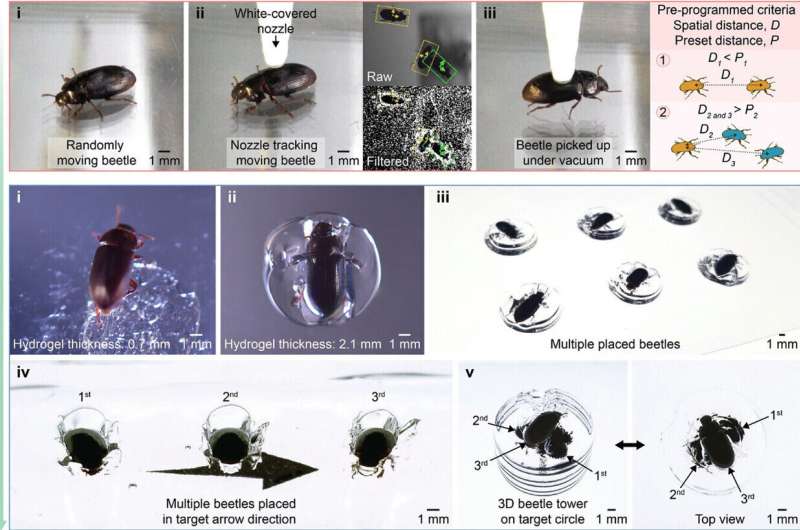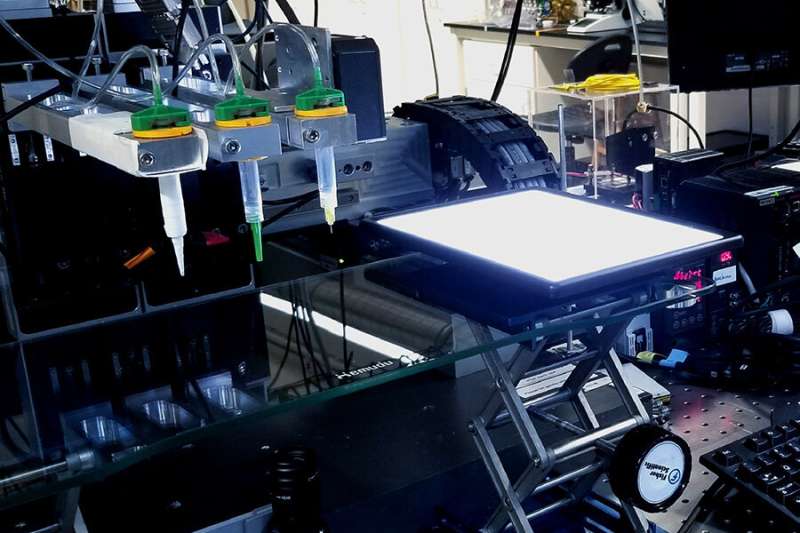This article has been reviewed according to Science X's editorial process and policies. Editors have highlighted the following attributes while ensuring the content's credibility:
fact-checked
peer-reviewed publication
trusted source
proofread
Adaptive 3D printing system can pick and place organisms for bioimaging and cryopreservation

A first-of-its-kind adaptive 3D printing system developed by University of Minnesota Twin Cities researchers can identify the positions of randomly distributed organisms and safely move them to specific locations for assembly. This autonomous technology will save researchers time and money in bioimaging, cybernetics, cryopreservation, and devices that integrate living organisms.
The research is published in Advanced Science entitled "3D Printed Organisms Enabled by Aspiration-Assisted Adaptive Strategies." The researchers have a patent pending on the technology.
The system can track, collect, and accurately position bugs and other organisms, whether they are stationary, in droplets, or in motion. The pick-and-place method guided by real-time visual and spatial data adapts and can ensure precise placement of the organisms.
"The printer itself can act like a human would, with the printer acting as hands, the machine vision system as eyes, and the computer as the brain," said Guebum Han, a former University of Minnesota mechanical engineering postdoctoral researcher and first author on the paper. "The printer can adapt in real-time to moving or still organisms and assemble them in a certain array or pattern."
Typically, this process has been done manually and takes extensive training, which can lead to inconsistencies in organism-based applications. With this new type of system, the amount of time decreases for researchers and allows for more consistent outcomes.

This technology could increase the number of organisms processed for cryopreservation, sort live organisms from deceased ones, place organisms on curved surfaces, and integrate organisms with materials and devices in customizable shapes.
It also could lay the groundwork for creating complex arrangements of organisms, such as superorganism hierarchies—organized structures found in insect colonies like ants and bees. In addition, the research could lead to advances in autonomous biomanufacturing by making it possible to evaluate and assemble organisms.
For example, this system was used to improve cryopreservation methods for zebrafish embryos, which was previously done through manual manipulation. With this new technology, the researchers were able to show that the process could be completed 12 times faster compared to the manual process. Another example showcases how its adaptive strategy tracked, picked up and placed randomly moving beetles, and integrated them with functional devices.
In the future, the researchers hope to continue to advance this technology and combine it with robotics to make it portable for field research. This could allow researchers to collect organisms or samples in areas that would normally be inaccessible.
In addition to Han, the University of Minnesota Department of Mechanical Engineering team included graduate research assistants Kieran Smith and Daniel Wai Hou Ng, Assistant Professor JiYong Lee, Professor John Bischof, Professor Michael McAlpine, and former postdoctoral researchers Kanav Khosla and Xia Ouyang. In addition, the work was in collaboration with the Engineering Research Center (ERC) for Advanced Technologies for the Preservation of Biological Systems (ATP-Bio).
More information: Guebum Han et al, 3D Printed Organisms Enabled by Aspiration‐Assisted Adaptive Strategies, Advanced Science (2024). DOI: 10.1002/advs.202404617
Journal information: Advanced Science
Provided by University of Minnesota




















